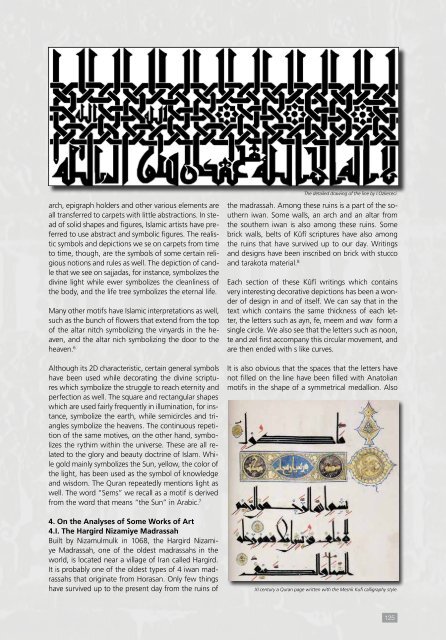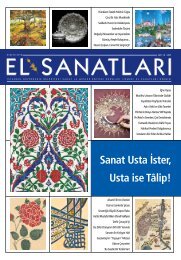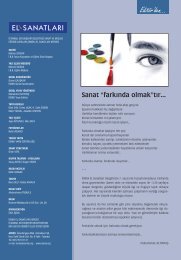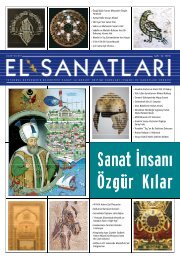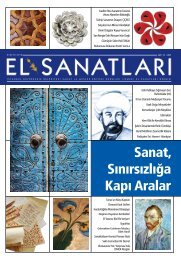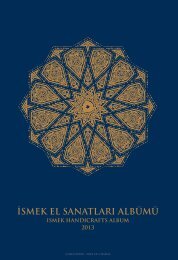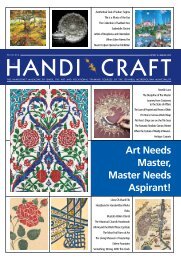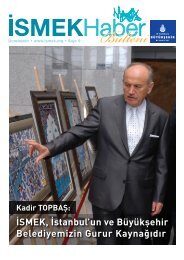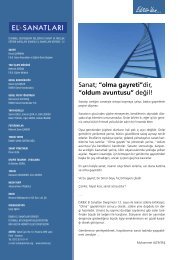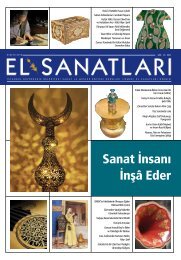You also want an ePaper? Increase the reach of your titles
YUMPU automatically turns print PDFs into web optimized ePapers that Google loves.
The detailed drawing of the line by I.Ozkececi.arch, epigraph holders and other various elements areall transferred to carpets with little abstractions. In steadof solid shapes and figures, Islamic artists have preferredto use abstract and symbolic figures. The realisticsymbols and depictions we se on carpets from timeto time, though, are the symbols of some certain religiousnotions and rules as well. The depiction of candlethat we see on sajjadas, for instance, symbolizes thedivine light while ewer symbolizes the cleanliness ofthe body, and the life tree symbolizes the eternal life.Many other motifs have Islamic interpretations as well,such as the bunch of flowers that extend from the topof the altar nitch symbolizing the vinyards in the heaven,and the altar nich symbolizing the door to theheaven. 6Although its 2D characteristic, certain general symbolshave been used while decorating the divine scriptureswhich symbolize the struggle to reach eternity andperfection as well. The square and rectangular shapeswhich are used fairly frequently in illumination, for instance,symbolize the earth, while semicircles and trianglessymbolize the heavens. The continuous repetitionof the same motives, on the other hand, symbolizesthe rythim within the universe. These are all relatedto the glory and beauty doctrine of Islam. Whilegold mainly symbolizes the Sun, yellow, the color ofthe light, has been used as the symbol of knowledgeand wisdom. The Quran repeatedly mentions light aswell. The word “Sems” we recall as a motif is derivedfrom the word that means “the Sun” in Arabic. 74. On the Analyses of Some Works of Art4.I. The Hargird Nizamiye MadrassahBuilt by Nizamulmulk in 1068, the Hargird NizamiyeMadrassah, one of the oldest madrassahs in theworld, is located near a village of Iran called Hargird.It is probably one of the oldest types of 4 iwan madrassahsthat originate from Horasan. Only few thingshave survived up to the present day from the ruins ofthe madrassah. Among these ruins is a part of the southerniwan. Some walls, an arch and an altar fromthe southern iwan is also among these ruins. Somebrick walls, belts of Kûfî scriptures have also amongthe ruins that have survived up to our day. Writingsand designs have been inscribed on brick with stuccoand tarakota material. 8Each section of these Kûfî writings which containsvery interesting decorative depictions has been a wonderof design in and of itself. We can say that in thetext which contains the same thickness of each letter,the letters such as ayn, fe, meem and wav form asingle circle. We also see that the letters such as noon,te and zel first accompany this circular movement, andare then ended with s like curves.It is also obvious that the spaces that the letters havenot filled on the line have been filled with Anatolianmotifs in the shape of a symmetrical medallion. AlsoXI.century a Quran page written with the Mesrik Kufi calligraphy style.125


